Bonsai trees, those miniature marvels of nature, bring joy to enthusiasts with their unique beauty- especially when they bloom with flowers. Have you ever wondered, “When do bonsai trees blossom?” This question often stirs curiosity among those nurturing these small yet captivating trees.
In the following sections, we’ll navigate the seasons, from spring’s vibrant blossoms to winter’s dormant beauty, providing essential insights for bonsai enthusiasts.
Prepare to be captivated as we explore the unique timeline of this blossoming beauty!
Understanding Bonsai Seasons

Bonsai trees, resembling miniature timepieces, gracefully navigate the changing seasons, each phase playing a significant role in their growth and blossoming. In spring, as nature renews itself, bonsai trees emerge from dormancy with delicate buds unfurling into vibrant blossoms. Patience becomes the key, allowing the tree to seamlessly transition from winter slumber to the lively spectacle of spring.
As summer arrives, bonsai trees revel in the warmth, showcasing vigorous growth and, in some species, additional blooms. Careful attention to the unique needs of your bonsai during this season is crucial for sustaining its overall health and vitality.
Come autumn, bonsai trees embrace a transformative beauty. Some species offer a second wave of blossoms, while others display spectacular fall foliage. This season is a time of preparation, ensuring your bonsai is ready for winter dormancy.
Though devoid of blossoms, winter brings a serene pause to the bonsai’s bustling growth. This period is vital, providing a time for rest and rejuvenation, with energy conserved for the following vibrant resurgence. Ensuring adequate protection from harsh winter conditions is critical to the overall well-being of your bonsai.
Understanding this natural rhythm is crucial for nurturing bonsai, and we’ll explore practical insights for each season ahead!
Spring Blossoms
Spring, the season of renewal and resurgence, orchestrates a magnificent symphony in bonsai. As winter is replaced, bonsai trees stir from their dormant state, ready to unveil a mesmerizing display of blossoms. When do bonsai trees blossom? This season, typically from March to May, marks the rebirth of life in the bonsai landscape.
The awakening in spring unfolds in distinct stages. First, the emergence of swollen buds, carefully protected during winter, hinting at the imminent burst of life. Tender leaves follow suit, unfurling and showcasing the bonsai’s distinctive foliage. The pinnacle of spring is the blossoming stage, where various bonsai species, including a Cherry Blossom tree, Azalea Bonsai, Crabapples, Plum trees, and Wisteria bonsai, showcase unique and vibrant blooms.
The bonsai landscape transforms into a riot of colors, adding a magical touch to the miniature scenery. This season also marks a period of heightened growth activity, as bonsai trees utilize abundant sunlight and favorable temperatures to produce new branches, leaves, and blossoms.
Bonsai Care in Spring
Caring for bonsai in spring becomes a delicate ritual. Adequate sunlight exposure fosters photosynthesis and encourages healthy growth. A cautious watering routine is vital when the flowers continue to bloom—water only on the soil and prevent the flowers from getting wet. Introducing a fertilizer with low nitrogen and higher phosphorus and potassium content supports robust flower development.
Spring temperatures, typically ranging from 50°F to 70°F (10°C to 21°C), create an ideal environment for bonsai growth and blossoming. Selective pruning directs energy toward budding areas, encouraging optimal blossom formation. Vigilance against pests that may emerge with warmer weather is crucial to protect budding leaves and blossoms.
Summer Growth and Blooms
Summer, a time of sun-soaked brilliance, brings forth a transformative chapter for bonsai trees, brimming with accelerated growth and vibrant blossoms. From June to August, these miniature wonders undergo a series of changes that define the essence of summer for bonsai enthusiasts.
During the summer months, a bonsai tree undergoes notable transformations. The trunk experiences a period of expansion and thickening, driven by the warmth and ample sunlight. Additionally, the bark on may develop unique textures, enhancing the tree’s visual appeal.
As summer unfolds, the bonsai’s leaves become a focal point of dynamic change. The tree responds to increased sunlight and longer daylight hours by producing a profusion of foliage, creating a lush and vibrant canopy. This surge in leaf production facilitates heightened photosynthesis, with leaves converting sunlight into energy to fuel the tree’s growth. Depending on the bonsai species, variations in leaf size and a deepening green color contribute to the overall health and vitality of the miniature tree.
Bonsai Care in Summer
Care and maintenance during summer are crucial for the bonsai’s well-being. Selective pruning becomes essential for managing exuberant growth, shaping the tree, and strategically directing energy. Watering routines must be consistent yet cautious, ensuring that the soil remains adequately moist without risking waterlogging. In the face of intense summer heat, protection, such as shading sensitive species or providing temporary coverings, becomes essential to prevent heat stress.
Autumn Colors and Blossoms
As autumn approaches, the bonsai landscape undergoes a captivating transformation as vibrant summer leaves transition into a rich tapestry of reds, oranges, and yellows, creating a visually enchanting fall foliage spectacle. While trunk growth may not be as rapid as in previous seasons, autumn adds a subtle charm to the bonsai’s appearance. The changing leaf colors accentuate the trunk’s structure, providing a captivating contrast against the bark.
Also, autumn is not typically a season known when bonsai trees bloom. It is when some bonsai trees shed their leaves. Among these are Japanese Maple, Chinese Elm, and deciduous evergreen bonsai species like the Redwood. Some bonsai trees may produce seeds as the leaves transition and gently fall. These seeds signify the completion of a growth cycle and promise future vitality, contributing to the bonsai’s ongoing life cycle.
Bonsai Care in Autumn
During this season, the watering routine becomes crucial, necessitating a delicate balance. Adjusting the watering frequency is essential as temperatures cool, allowing the soil to dry slightly between sessions to prevent overhydration. Gentle pruning practices take center stage, focusing on removing fallen leaves and any dead or yellowing foliage. This not only maintains the aesthetic appeal of the bonsai but also promotes a healthy transition into the dormant winter months.
Protective measures against harsh winds are considered, especially for more delicate bonsai species, safeguarding them from potential stress. Autumn care embodies a harmonious approach, respecting the natural rhythms of the bonsai’s life cycle and ensuring its well-being as it gracefully prepares for the serene months ahead.
Winter Dormancy
Winter bestows serene tranquility upon the bonsai landscape, ushering the miniature trees into a phase of dormancy where subtle yet transformative changes unfold. Once marked by growth and thickness, the trunk now enters a quiet stasis, and the bark, having shed the vibrant colors of autumn, takes on a more subdued tone, revealing the refined structure beneath.
As winter progresses, some flowering bonsai trees- deciduous species, also shed their leaves, and the absence of leaves is a characteristic feature. While winter is not synonymous with blossoms for other bonsai tree species, occasional flower buds may emerge, offering a glimpse of the vitality that lies dormant within.
Bonsai Care in Winter
Winter care for bonsai demands a gentle and considerate touch to nurture these miniature trees through their dormant phase. One of the adjustments involves watering, where a delicate balance is struck between preventing the soil from drying out entirely and avoiding overhydration.
This season also calls for minimal pruning activities, primarily removing dead or decaying branches to maintain the bonsai’s health. Safety measures are crucial for more delicate bonsai species susceptible to the cold. This might involve shielding them from harsh winds, providing a slightly warmer microclimate, or using frost covers.
Year-Round Maintenance
Year-round maintenance forms the backbone of bonsai care, ensuring these miniature trees’ overall health and vitality. Emphasizing consistent care practices is paramount for sustaining the well-being of the bonsai throughout every season. Enthusiasts should adopt a mindful approach to watering, adjusting their routine based on seasonal requirements to strike the right balance between hydration and moderation.
Though more extensive during active growth periods, pruning activities should be addressed in dormant phases, focusing on removing dead or decaying branches. Safety against harsh weather conditions, such as frost or excessive wind, contributes to the tree’s resilience.
Monitoring and adjusting represent essential facets of year-round care. Enthusiasts are encouraged to closely observe their bonsai’s progress, keeping an eye on budding and leaf development. This vigilant monitoring allows for timely adjustments in care practices, ensuring that the bonsai receives tailored attention in response to evolving needs.
Whether it’s adapting watering frequencies, providing additional support during adverse weather, or making subtle changes to the placement of the bonsai, this attentive approach fosters a dynamic and responsive relationship between the caretaker and the miniature tree. In the bonsai world, year-round maintenance is not merely a routine; it is a continuous dialogue between the enthusiast and the living work of art, allowing both to thrive in harmony.
Bonsai Calendar

Encouraging bonsai enthusiasts to craft their Bonsai Calendar is a practical step towards a deeper connection with their flowering trees. This calendar begins with a simple understanding of the specific bonsai species in one’s care. By noting key characteristics, such as the natural growth patterns, flowering seasons, and responses to different environmental conditions, individuals can tailor their care routines to suit the unique needs of each tree.
Tracking progress in the Bonsai Calendar involves a straightforward yet insightful approach. Enthusiasts can observe and record the blossoming patterns of their bonsai throughout the year. Include noting the timing, duration, and intensity of blooms. By maintaining a visual record or a simple log, caretakers gain valuable insights into their bonsai’s health and response to care practices. This proactive approach facilitates adjustments in care routines, allowing enthusiasts to fine-tune watering, pruning, and protective measures based on the observed patterns.
Troubleshooting Blossoming Issues
Bonsai enthusiasts may encounter various issues hindering the blossoming of their flowering plants. Inadequate sunlight, improper watering, poor soil quality, and incorrect temperatures can interfere with growth. To address these challenges, adjust sunlight exposure based on the bonsai species, considering supplementary lighting if needed—Fine-tune watering practices by checking soil moisture regularly and optimizing the soil with a well-draining mix.
Monitor and adjust temperature environments to align with the bonsai’s preferences. Regular inspections for pests and diseases help prevent issues that could impact blossoming. Implementing these practical solutions ensures a conducive environment for vibrant and healthy blossoms, allowing one to enjoy the beauty of their miniature trees.
Conclusion
In bonsai cultivation, understanding the crucial question of when do bonsai trees blossom becomes a cornerstone of success. We’ve demystified the seasonal rhythms, offering practical insights for enthusiasts seeking to nurture thriving bonsai landscapes. Crafting a Bonsai Calendar and troubleshooting common issues related to the blossoming timeline ensures simplicity in care routines.
Adjusting sunlight, fine-tuning watering, and staying vigilant against pests collectively foster an optimal environment for these miniature trees to blossom joyfully. With this knowledge, may you witness the bonsai landscapes’ growth and resilience, creating your haven of blooming beauty!





0 Comments